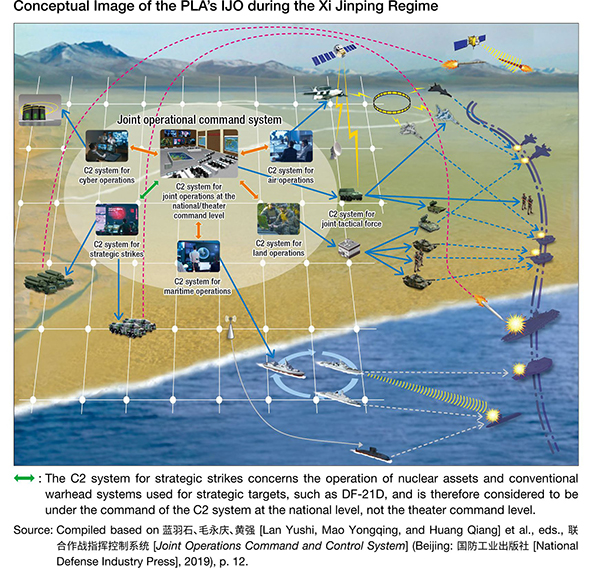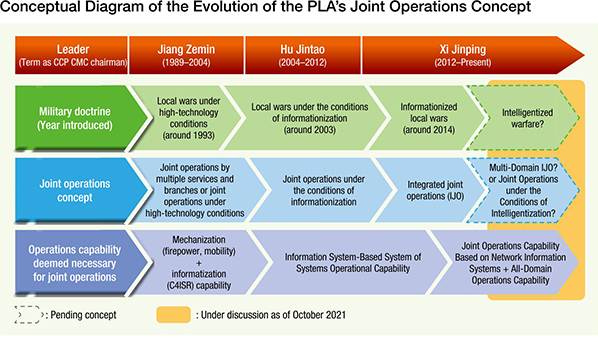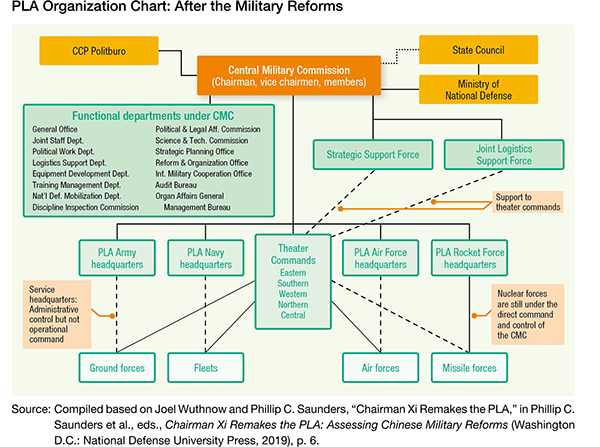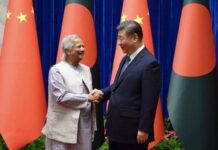Evolution of the PLA’s Joint Operations Concept
Based on the outcome of the Gulf War, the PLA started researching joint operations in earnest with informatized warfare in mind. From the mid-2000s, the PLA advocated the IJO concept and “Information System-Based System of Systems Operational Capability,” and presented a joint operations concept that included traditional security domains (land, sea, and air) and new security domains (such as space, cyber electromagnetic, and cognitive domain). Meanwhile, during the Hu Jintao regime, the PLA’s informatization was still in the initial stage. Therefore, the PLA set forth that, for the time being, the feasible joint operations were “joint operations under the conditions of informationization,” which was based on the military doctrine of “local wars under the conditions of informationization.” The joint operations capabilities of the PLA had not necessarily reached a sufficient level in the Hu Jintao era.
The Xi Jinping leadership established “informationized local wars” as a military doctrine. Under this doctrine, the Xi leadership undertook large-scale military reforms in order to strengthen joint operations capabilities based on the IJO concept and “Information System-Based System of Systems Operational Capability.”
In October 2017, at the 19th National Congress of the Chinese Communist Party, Xi advocated the new concepts of “Joint Operations Capability Based on Network Information Systems” and “All-Domain Operations Capability” in order to deepen the IJO concept. The implementation of precision, stealth, and unmanned operations, as well as the gaining of information dominance, are positioned at the core of these concepts, putting more pronounced emphasis on new security domains.
With “intelligentized warfare” proposed from 2019, the PLA is conducting ongoing research on new joint operations concepts, such as “Multi-Domain Integrated Joint Operations” and “Joint Operations under the Conditions of Intelligentization.” These discussions include the possibility of further PLA reforms, such as the establishment of new military services and the implementation of bolder military reforms.
The Reformed PLA’s Joint Operations Structure
The PLA carried out large-scale military reforms from the end of 2015 to 2016. The reforms were wide-ranging and included:
(1) the dissolution of four general departments and the launch of the multi-department system of the Central Military Commission (CMC); (2) the abolition of the seven military regions (MRs) and the establishment of five theater commands (TCs); (3) the creation of the PLA Army headquarters; (4) the upgrading of the PLA Second Artillery Corps to the PLA Rocket Force and the launch of the PLA Strategic Support Force and the PLA Joint Logistics Support Force; and (5) the expansion of the PLA Navy Marine Corps.
The PLA reforms clarified the distinction between the operational chain of command (CMC-TC headquarters-operational units) and the administrative chain of command (CMC-service headquarters-operational units), based on the policy of “the CMC performs general management, the theaters are mainly in charge of operations, and the services are mainly in charge of force building”. Under this policy, TCs were described as “the only supreme joint operations command organization in their respective strategic directions.” The TCs have greater power and command and control (C2) authority than the MRs before the PLA reforms and have gained in importance.
As part of the PLA reforms, the C2 authority of the People’s Armed Police (PAP) was centralized in the CMC, and the China Coast Guard (CCG) was placed under the PAP, creating the new CMC-PAP-CCG maritime border security management system.
Enforcing the CMC chairman responsibility system strengthened Xi Jinping’s C2 authority over the PLA. In addition, under Xi’s leadership, loyalty to Xi and joint operations were emphasized for selection of the PLA leadership. Nevertheless, PLA Army personnel still dominate the TC headquarters.
With the formation of the standing CMC Joint Operations Command Center and TC Joint Operations Command Organizations, the PLA established a joint operations command structure for “unification of peacetime structure and wartime structure”. In addition, the PLA has been developing C2 systems for joint operations, interconnecting them with the C2 systems of the military services and integrating them with the C2 systems of government organizations and the civilian sector.
The Transformation of Joint Operations Training and Talent Cultivation Programs through the PLA Reforms, and the Quest for Strengthening Party-Army Relations
In accordance with Xi Jinping’s instruction to become an army that is “ready to fight and win wars,” the PLA further strengthened its joint operations training after the PLA reforms, stepped up trainings in Taiwan’s vicinity and in the South China Sea, and is enhancing its capabilities for commanding joint operations in China-Russia joint exercises. Through a series of joint operations trainings, the PLA has especially strengthened information sharing among the services and connecting their C2 systems. In addition, the PLA improved the quality of trainings by strengthening the training supervision structure.
In order to overcome the shortage of personnel for commanding joint operations, the PLA developed the “triad” System for training new types of military personnel, consisting of military institutional education, unit training practice, and military professional education (online education). The PLA National Defense University is the central academy for cultivating personnel for joint operations, and the joint operations personnel who have been trained at the university are assigned to operational units.
The PLA sought to strengthen the education and training structure by establishing and improving related documents, laws, and regulations. In terms of training, the PLA updated the “Military Training Regulations” and the “Military Training Outline” and enacted the “Trial Guidelines on PLA Joint Operations.” In terms of education, it enacted the “Military Education Policy in the New Era,” the “Trial Regulations on the Education in Military Academies,” and the “Trial Regulations on Military Professional Education for Armed Forces.”
As the PLA strengthens its joint operations structure, some scholars note that the traditional system for maintaining Party-Army relations will become a setback. To address this, the PLA seeks the coexistence of the IJO concept and the maintenance and strengthening of Party-Army relations by: (1) enforcing the “system of division of the leader’s responsibilities under the unified collective leadership of the Party committee”; (2) focusing on military expertise and scientific and technological knowledge in the selection and cultivation of political officers; and (3) emphasizing the “Three Warfares” and promoting informatization in wartime political work.
Internal Structure of Main Command Post of TC Joint Operations Command
The Commanding officers in the TC JOCO (commander and political commissars) are:
• Intelligence Center
• Communication Center
• C2 Center (Info Warfare, AD and Special Ops Centres)
• Military Affairs & Mobilization Center
• Political Work Center
• Logistic and Equipment Center
• Command Support Center
Conclusion
Since the 1990s, the PLA has advocated IJO, a concept with broad applicability, in order to adapt flexibly to the developments in U.S. military theories and science and technology. The PLA sought to deepen the IJO concept by pursuing uniqueness, combining tradition (such as “Three Warfares,” military-civil fusion, and maintenance and strengthening of Party-Army relations) and innovations (such as emphasis on long-range precision attack capability, shift to new security domains, and intelligentized warfare).
Under the strong initiative of Xi Jinping, the PLA reforms developed a joint operations structure that can realize the IJO concept. In line with this, the PLA evolved its joint operations training and personnel cultivation programs and aimed to reconcile the effective execution of the IJO concept and the maintenance and strengthening of Party-Army relations.
In the PLA reforms, the PLA accomplished many achievements in deepening its joint operations. Meanwhile, there still remain numerous challenges even after the reforms, such as: (1) coordination of authority and roles among the CMC, TCs, and services; (2) insufficient awareness of joint operations and service parochialism; (3) the formalism of joint operations training and coordination between the joint operations training led by the TCs and the training of the services and branches; (4) difficulties with recruiting, cultivating, and retaining personnel skilled in science and technology; and (5) the nature of command authority and capability of political commissars. Overcoming these challenges is expected to take time.
The timetable for the PLA’s modernization sets 2027, 2035, and 2050 as milestone years. In these years, it will be important to estimate the joint operations capabilities of the PLA from multiple aspects, paying attention not only to the increase in defense spending, introduction of new equipment, and statements and actions directed at other countries, but also to the PLA’s joint operations concept, military reforms and the formation of an organizational culture, qualitative improvements in education and training and personnel, and Party-Army relations.
Based on the NIDS, Japan, China Security Report 2022





















